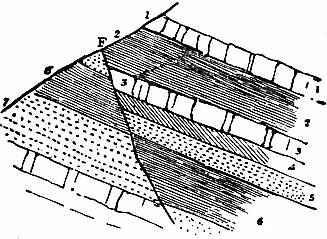that most normal and reversed faults are due to simple vertical
movements of the fractured crust-blocks; but this is by no means
the case. What is actually observed in examining a fault is
the apparent direction of motion; but the present position of
the dislocated masses is the result of real motion or series of
motions, which have taken place along the fault-plane at various
angles from horizontal to vertical; frequently it can be shown
that these movements have been extremely complicated. The
striations and “slickensides” on the faces of a fault indicate
only the direction of the last movement.
 |
| Fig. 8.—Diagram of gently undulating strata cut by a fault,
with alternate throw in opposite directions. |
 |
| Fig. 9.—Section of strata cut by step faults. |
 |
| Fig. 10.—Trough faults. |
 |
| Fig. 11.—Plan of a strike fault. |
 |
| Fig. 12.—Section across the plan, fig. 11. |
A broad monoclinal fold is sometimes observed to pass into
a fault of gradually increasing throw; such a fault is occasionally
regarded as pivoted at one end. Again, a faulted mass may be
on the downthrow side towards one end, and on the upthrow
side towards the other, the movement having taken place about
an axis approximately normal to the fault-plane, the “pivot”
in this case being near the centre. From an example of this
kind it is evident that the same fault may at the same time be
both “normal” and “reversed” (see fig. 8). When the principal
movement along a highly inclined fault-plane has been approximately
horizontal, the fault has been variously styled a lateral-shift,
transcurrent fault, transverse thrust or a heave fault. The
horizontal component in faulting movements is more common
than is often supposed.
A single normal fault of large throw is sometimes replaced
by a series of close parallel faults, each throwing a small amount
in the same direction; if these subordinate faults occur within
a narrow width of ground they are known as distribution faults;
if they are more widely separated they are called step faults
(fig. 9). Occasionally
two normal faults
hade towards one
another and intersect,
and the rock mass
between them has
been let down; this is
described as a trough
fault (fig. 10). A fault
running parallel to
the strike of bedded
rocks is a strike fault;
one which runs along
the direction of the
dip is a dip fault; a
so-called diagonal fault takes a direction intermediate between
these two directions. Although the effects of these types of
fault upon the outcrops of strata differ, there are no intrinsic
differences between the faults themselves.
 |
| Fig. 13.—Plan of strata cut by a dip fault. |
 |
| Fig. 14.—Plan of strata traversed by a diminishing strike fault. |
 |
| Fig. 15.—Plan of an anticline (A) and
syncline (S), dislocated by a fault. |
 |
| Fig. 16.—Section along the upcast side
of the fault in fig. 15. |
 |
| Fig. 17.—Section along the downcast
side of same fault. |
The effect of normal faults upon the outcrop may be thus
briefly summarized:—a strike fault that hades with the direction
of the dip may cause beds to be cut out at the surface on the
upthrow side; if it hades against the dip direction it may repeat
some of the beds on the upthrow side (figs. 11 and 12). With
dip faults the crop is carried forward (down the dip) on the
upthrow side. The perpendicular distance between the crop
of the bed (dike or vein) on opposite sides of the fault is the
“offset.” The offset decreases with increasing angle of dip
and increases with increase in the throw of the fault (fig. 13).
Faults which run obliquely across the direction of dip, if they
hade with the dip of the strata, will produce offset with “gap”
between the outcrops; if they hade in the opposite direction
to the dip, offset with “overlap” is caused: in the latter case
the crop moves forward (down dip) on the denuded upthrow
side, in the former it moves backward. The effect of a strike
fault of diminishing throw is seen in fig. 14. Faults crossing
folded strata cause the outcrops to approach on the upthrow
side of a syncline and tend to separate the outcrops of an anticline
(figs. 15, 16, 17).
In the majority of cases the upthrown side of a fault has been
so reduced by denudation as to leave no sharp upstanding
ridge; but examples are known where the upthrown side still










